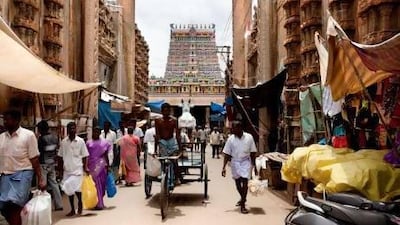Why Madurai?
In Madurai, all roads lead to the temple of Meenakshi, the fish-eyed goddess. Madurai is one of the oldest living cities of India, mentioned in texts as far back as the 2nd century BC. In this city, history and mythology go hand in hand and the streets echo with stories of kings and queens, and of gods and goddesses.
In more ways than one, Madurai is all about woman power. It has one of the few temples in India dedicated exclusively to the goddess Parvati in the form of Meenakshi, who was married to Shiva here. Legend also has it that the ancient city burst into flames upon the curse of a wronged woman Kannagi, and rose from the ashes.
Thirumalai Nayakar Mahal, an early 17th century palace is another must-visit. Its architecture is a mix of Dravidian, Indo-Saracenic and Gothic styles. If you can, catch the interesting sound and light show at 6.45pm daily in English.
Despite being the second-largest city in the state of Tamil Nadu, Madurai retains a small-town charm. It is common to see women with jasmine flowers in their hair, draped in traditional nine- yard saris walking towards the temple or gossiping together on street corners for hours on end, unhurried by modern life.
A comfortable bed
For a feel of rustic Tamil Nadu in the heart of Madurai, check into the Heritage Madurai (www.heritagemadurai.com), spread over 17 acres. The resort was designed by the famous Sri Lankan architect Geoffrey Bawa, who incorporated modern elements into what was once the prestigious Madurai Club. A double room costs from 6,293 rupees (Dh437) including taxes.
Or get away from the crowds and the chaos that is Madurai to the Gateway Hotel (www.thegatewayhotels.com on the hills of Pasumalai, just five kilometres from the city, from7,200 rupees (Dh497) for a standard room.
Find your feet
The town, at least the part of it that visitors will head to, is easily done on foot. Start from one of the main gates of the Meenakshi temple and walk your way through the narrow streets that are lined on either side with shops.
Take half a day to explore the Meenakshi temple complex. Apart from the temple itself, there is a water tank, a small covered market and the Thousand Pillar Hall dating back to the 16th century.
If you would like a more detailed tour of Madurai, sign up with Storytrails (www.storytrails.in; 0091 44 4212 4214) for a two-hour morning walk.
Meet the locals
Walking in the streets that spread out in concentric squares around the temple is the best way to observe local life. Everyone in Madurai visits this area at least once a week - if not to visit the temple itself, then to shop for everything from groceries and glass bangles to saris and shirts.
Book a table
Murugan Idli Shop (www.muruganidlishop.com) at the West Masi Street serves the fluffiest idlis anywhere in the country, accompanied by a variety of spicy chutneys. Murugan, which began as a modest hole-in-the-wall, has now spread all the way to Chennai and Singapore.
Although most of the high-end hotel restaurants will claim to be "multi-cuisine", ask for the Madurai specialties from their menu. At the Banyan Restaurant at Heritage Madurai, try some richly flavoured Chettinadu cuisine, which comes from the neighbouring region, like thakkali katti kuzhambu (thick stew with tomato), mutton chukka (dry mutton) and yeral masala (prawn gravy), served with gauni arisi (red rice cooked with spice and sugar). A meal for two will cost about 1,800 rupees (Dh124).
Shopper's paradise
Madurai is known for it high quality, bright cotton saris and fabrics, locally known as sungudi. This local, tie-dye fabric can be found in any of the garment shops around the temple. Try Ranee Saris on South Maasi Street or Alankar Textiles on South Avani Moola Street for a wide range.
The government-managed Poompuhar Emporium on East Avani Moola Street has beautiful brass and bronze handicrafts at reasonable prices. You could also pick up a lamp made of bell metal or a richly carved box in wood. Another good place for local handicrafts is the Cottage Arts Emporium on North Chithrai Street.
What to avoid
The summer months, between April and July, are unbearably hot and best avoided. That said, Madurai is hot through the year, so be sure to carry lots of light cotton clothes when you go.
Don't miss
It is believed that the Mughals brought in jigarthanda, which literally translates as "heart-cooler", now a local delicacy. It is a sinful concoction of milk, almonds, sarsaparilla syrup and vanilla ice cream. The best jigarthanda is usually found at the street stalls; try it at Famous Jigarthanda on East Marret Street. One glass of jigarthanda (30 rupees; Dh1) is a meal in itself and enough to keep you going for several hours.
Getting there
Etihad (www.etihad.com) flies direct from Abu Dhabi to Chennai in four hours, from Dh1,400 return. From Chennai you can take a connecting flight or an overnight train (www.irctc.co.in) to Madurai.
artslife@thenational.ae
Follow us

